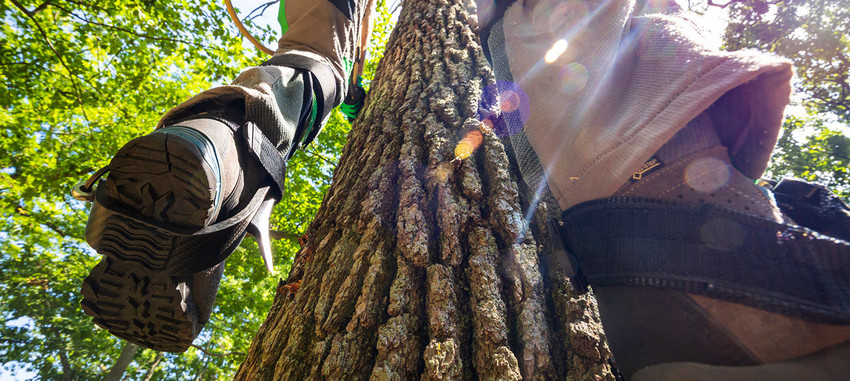Choosing the Right Climbing Spikes
Sherrilltree Jun 1st 2023Looking for a set of Spikes, Climbers or Gaffs?
Start here before you buy to help you find the right product for you. No matter what you call them, we are talking about how to understand all the different types, models, and aspects of them.
No matter what you call them, we are talking about how to understand all the different types, models, and aspects of them. Before we jump into understanding these tools, we first must have some common language around them as well as what they are used for.
Shin cup – upper pad that goes around the top of the lower leg, ideally about 2” of gap between the top of the pad and the bottom of the knee joint.
Shank – the metal, aluminum or carbon fiber piece that connects the shin cup to the lower part of the climber. Usually one or two pieces, two-piece shanks are adjustable and have screws in them that need to be checked periodically for tightness.
Gaff – the spike part that goes into the tree, there are two main types of gaffs. Pole and Tree, pole gaffs are shorter and have more of an angle whereas tree gaffs are longer and less angled. However, each manufacture might make them differently.
Lower strap – this is the part that secures your foot to the stirrup of the shank, usually attached to the shank with some type of connector.
Stirrup – the part of the shank that your foot stands on, designed to sit on the rear of the arch near the heel of a boot.
Pole vs. Tree Gaffs
The easiest way to start this process is by breaking them down into two categories, based on the type of climber it is: either pole or tree gaff. Some of this is personal preference of what someone might like, but there are some general guides regarding these two types.
Pole gaffs are generally better for thin bark hardwood trees, such as maples, while tree gaffs are generally better for thicker bark softwood trees, such as pines. However, usage and personal experience will lead you to the best choice for your climbing style and also knowing that gaffs come in a range of lengths as well. Pictured on Notch Gecko Aluminum 2.0 Climbers.
Replaceable vs. Non-Replaceable Gaffs
Next, you need to consider replaceable vs. non-replaceable gaffs. Gaffs wear down over time and therefore need to be sharpened. When sharpening them, always follow manufacture recommendations and use the inspection guide that comes with all climbers. Once a gaff is no longer meeting the minimum requirements, it’s time to replace them, if you have a set of climbers with replaceable gaffs it's as simple as two bolts, however if you have a set of climbers with fixed or non-replaceable gaffs you will need to replace the entire climber. Consider using a gaff gauge when you sharpen your gaffs.
Material
Once you have figured out what style and type of gaff you wish to have, the next choice is in what material you want your climber to be made from. Generally, there are three options:
- Steel
- Aluminum
- Carbon Fiber
There are some other options, such as titanium, but for the most part you will have 3 choices. Each choice of material has its good and bad, and it truly is a matter of weighing out the pros and cons for you in what you value. Steel climbers are heavy but less expensive, Aluminum is lighter and slightly more expensive and Carbon Fiber is the lightest but most expensive. However, I will add that climbers that are well maintained and cared for should last 7-10 years, so this is truly a long term investment for most tree workers, and I always looked at what the initial cost of the climbers would be spread out over that duration of use.
Shin Cups & Straps
Once you have decided on your gaff style/type and the material you wish to have the climber be, the next and last choice is what type of shin cup and strap do you want. Shin cups come in a large variety of styles and amount of padding. Some tree workers prefer formed shin cups like the Carbon Fiber Geckos, and some prefer the more flexible type such as Weaver Leather Pads. Once again, this is going to come down to personal preference and what you value. Heavy padding is nice, but it adds weight and isn’t always best in hot environments due to the insulation it provides. Yet formed shin cups are good for some people but are not adjustable for a one size fits all calf. For workers with larger or smaller calf muscles, you might struggle with a comfortable fit with a formed shin cup.
Regarding the straps, there are pretty much only two options here: Velcro and Leather. Velcro is fast and offers micro adjustment, whereas leather is durable and won’t have need for regular cleaning of debris that Velcro requires to keep the hook and loop material functioning properly.
Hopefully this helps to better understand the differences and guide you on your journey of choosing the best spikes, climbers or gaffs — no matter what you call them — for you!
Climb safe, cut safe.

